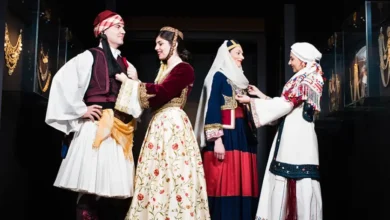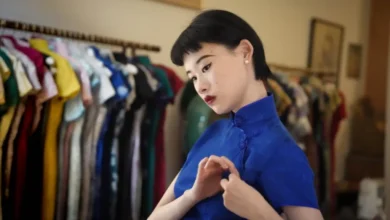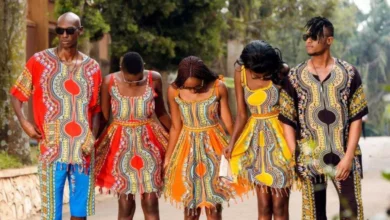The vibrant and elaborate clothing worn in Candomblé ceremonies is not merely decorative. Each garment, particularly the iconic Baiana dress, carries deep spiritual and cultural significance. This article will explore the rich history, symbolism, and craftsmanship behind the Baiana dress, a fundamental element of Brazil’s Afro-Brazilian religion, Candomblé.
Understanding Candomblé: A Brief Overview
Before diving into the specifics of the Baiana dress, it’s essential to understand the context of Candomblé. This Afro-Brazilian religion originated in Brazil during the transatlantic slave trade, evolving from the traditions and beliefs of various West African peoples, particularly the Yoruba, Fon, and Bantu.
Candomblé honors the Orixás, powerful deities who each have distinct characteristics, domains, and preferences. These divinities are central to the ceremonies and daily life of practitioners. The religion blends West African spirituality with aspects of Catholicism and indigenous Brazilian beliefs, creating a unique and dynamic system.
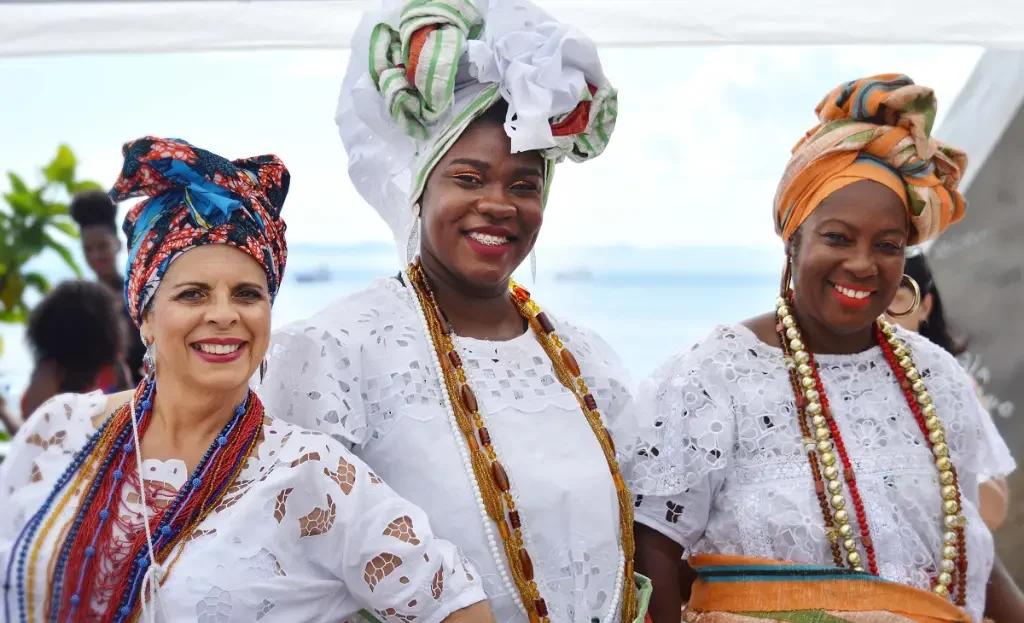
Key Elements of Candomblé Practice
- Orixás: The central deities who are worshipped.
- Rituals and Ceremonies: These form the core of religious practice, involving music, dance, and offerings.
- Music and Dance: Essential forms of communication with the Orixás.
- Offerings: Include food, drinks, and other items that are used to honor the deities.
- Clothing: Plays a vital role, signifying the practitioner’s role and the Orixá they are honoring.
The Baiana Dress: More Than Just Clothing
The Baiana dress, also known as the vestimenta de Baiana, is an integral part of Candomblé ceremonies. This elaborate attire, characterized by its layers of fabric, vibrant colors, and intricate details, is not simply a costume but a symbolic representation of spirituality, identity, and cultural heritage. It’s the dress worn by the ‘Filhas de Santo‘ or “Daughters of the Saints“, women initiates in the Candomblé religion during important ceremonies.
See also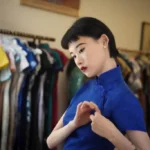 The Cheongsam: A Timeless Garment in Chinese Celebrations
The Cheongsam: A Timeless Garment in Chinese CelebrationsThe term “Baiana” comes from the state of Bahia in Brazil, the cradle of Candomblé in the country. The dress reflects the cultural richness of this region, blending African traditions with Portuguese colonial influences. The Baiana dress is a powerful emblem of Afro-Brazilian resistance and cultural preservation.
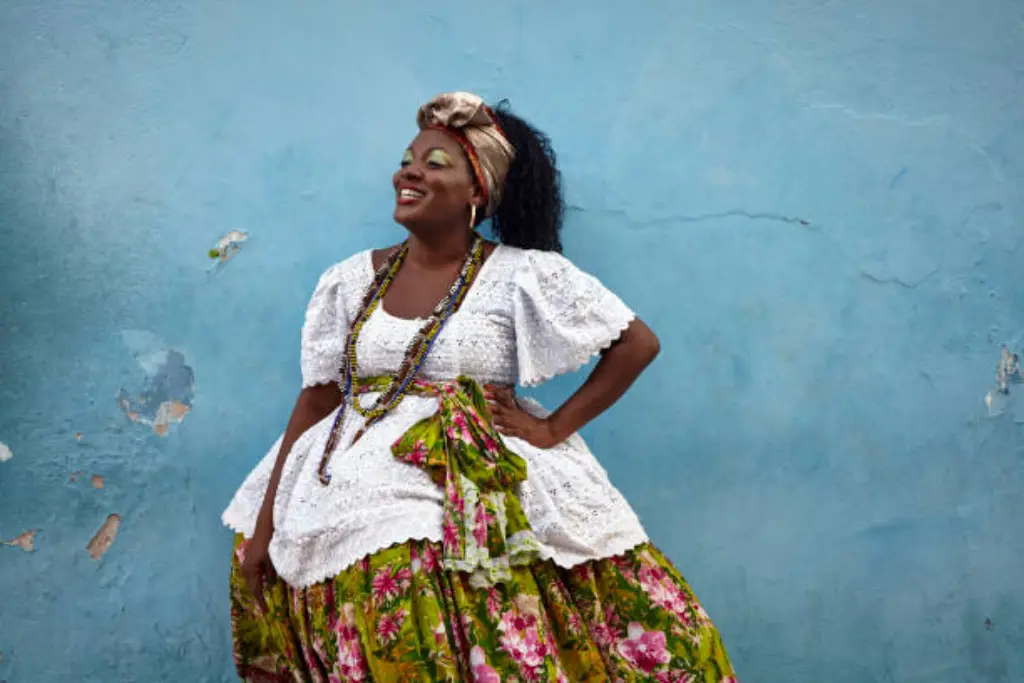
Key Features of the Baiana Dress
The Baiana dress is comprised of several components, each with its significance:
- Camisú (Chemise): The white cotton under-dress that serves as the base layer, symbolizing purity.
- Saia (Skirt): Often full and multi-layered, made from vibrant fabrics like brocade, silk, or cotton. The number of layers can signify rank or the importance of the ceremony.
- Torço (Headwrap): A crucial element, the torço is made of a fabric intricately wrapped around the head. Its style and color can vary, denoting the Orixá being honored.
- Pano da Costa (Shoulder Cloth): A long rectangular piece of fabric worn over the shoulder. Like the other fabrics, its color and material can be symbolic.
- Joias (Jewelry): Necklaces, earrings, and bracelets, often made of beads or metal, are carefully chosen to complement the outfit and often reflect the specific Orixá.
- Panos (Decorative Cloths): Other fabrics and small, decorative cloths can be used to add to the visual splendor of the attire.
The Symbolic Meaning of Color
In Candomblé, colors are not arbitrary. They hold deep spiritual meaning and are directly connected to the different Orixás. Each deity has a preferred color or set of colors, which are reflected in the Baiana dress worn in their honor. This helps in identifying and connecting with the specific Orixá invoked during a ceremony.
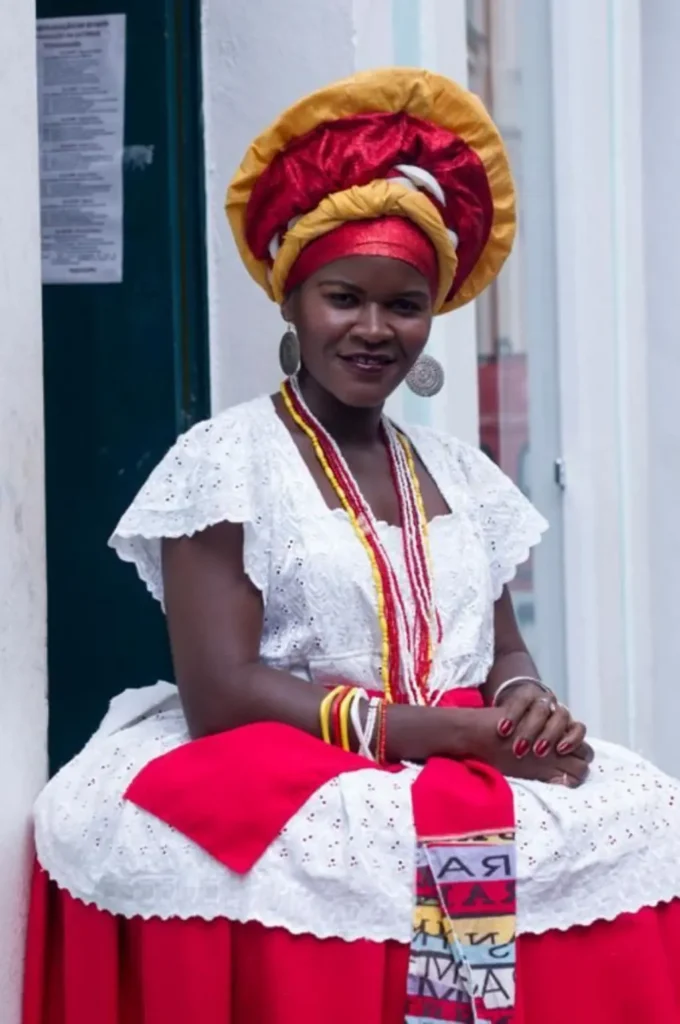
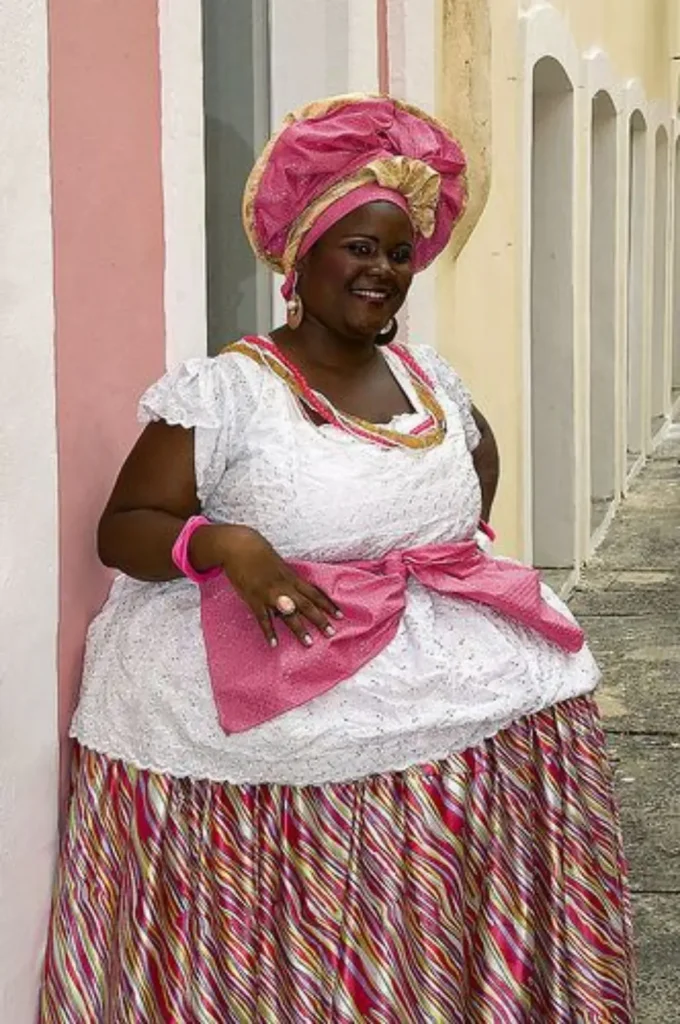
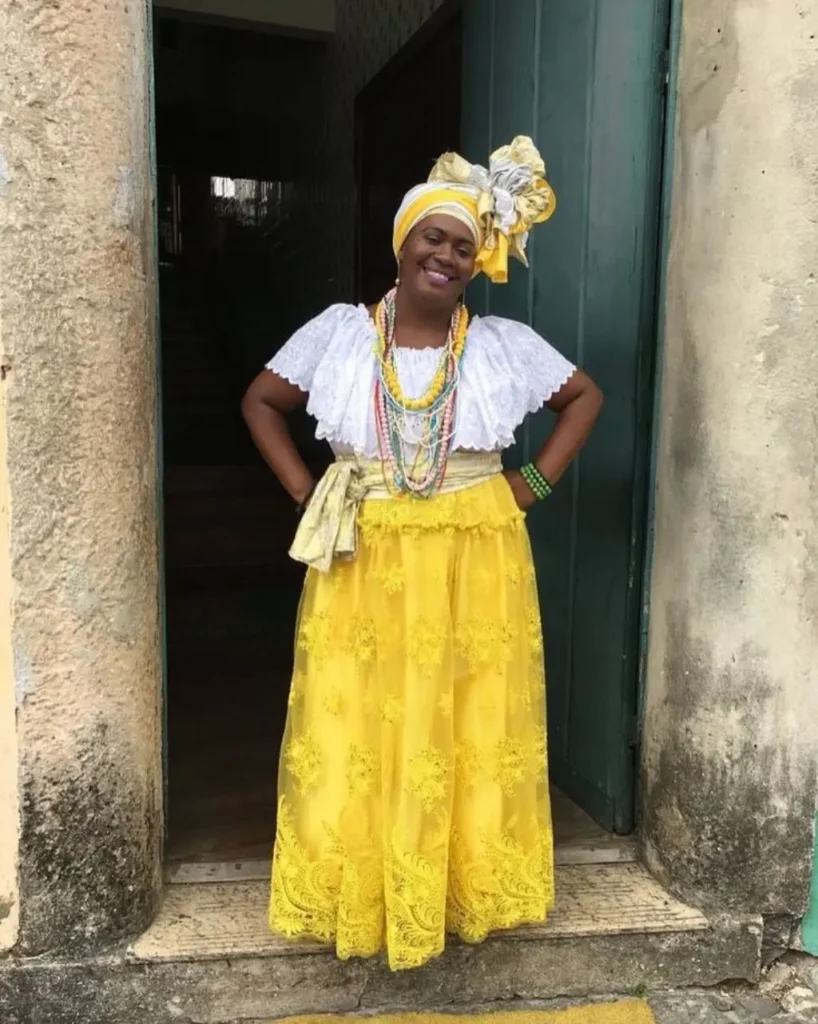
Common Colors and Their Associated Orixás
- White: Represents Oxalá, the oldest of the Orixás, symbolizing purity, peace, and creation.
- Blue: Associated with Yemanjá, the goddess of the sea, signifying fertility, motherhood, and protection.
- Yellow and Gold: Represent Oxum, the goddess of love, beauty, and wealth. These colors also symbolize prosperity and abundance.
- Red and White: Are often seen for Xangô, the god of thunder and justice, symbolizing power, strength, and authority.
- Green: Linked to Oxóssi, the god of the hunt and forests, representing nature, abundance, and wisdom.
- Purple: Sometimes associated with Nanã, the oldest water deity and the mother of the earth.
The specific shade and combinations of colors within the Baiana dress are carefully chosen by the initiated, known as ‘Filhas de Santo’, and their religious leaders. These choices reflect a deep understanding of the specific Orixá being honored.
See also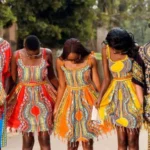 The Dashiki’s Presence in African Naming Ceremonies and Festivals
The Dashiki’s Presence in African Naming Ceremonies and FestivalsThe Craftsmanship of the Baiana Dress
Creating a Baiana dress is an art form passed down through generations. The intricate details and layers of fabric require significant skill and time. Many practitioners within the Candomblé community learn these skills, reinforcing the interconnectedness between the religion and its material culture.
Process of Making the Baiana Dress
The creation of a Baiana dress often involves several steps:
- Fabric Selection: Choosing appropriate fabrics based on color, texture, and pattern, as dictated by the specific Orixá.
- Cutting and Sewing: Carefully cutting and sewing the various pieces of the dress, from the camisú to the multiple layers of the saia.
- Headwrap Construction: Creating the torço, which can be a complex task involving specific folds and knots.
- Beadwork and Embellishments: Adding beads, lace, and other embellishments, all of which hold particular significance.
- Final Assembly: Carefully assembling each part to create the complete and harmonious ensemble.
The skill of making Baiana dresses is highly valued and often seen as a sacred task. It involves not only technical ability but also a deep understanding of the religious and cultural symbolism embedded in the clothing.
The Role of the Baiana Dress in Candomblé Ceremonies
The Baiana dress plays several vital roles in Candomblé ceremonies. It transforms the wearer, allowing them to embody the spirit of the Orixá they are honoring. The dress helps the “Filhas de Santo” connect deeply with the deities and the collective energy of the religious gathering.
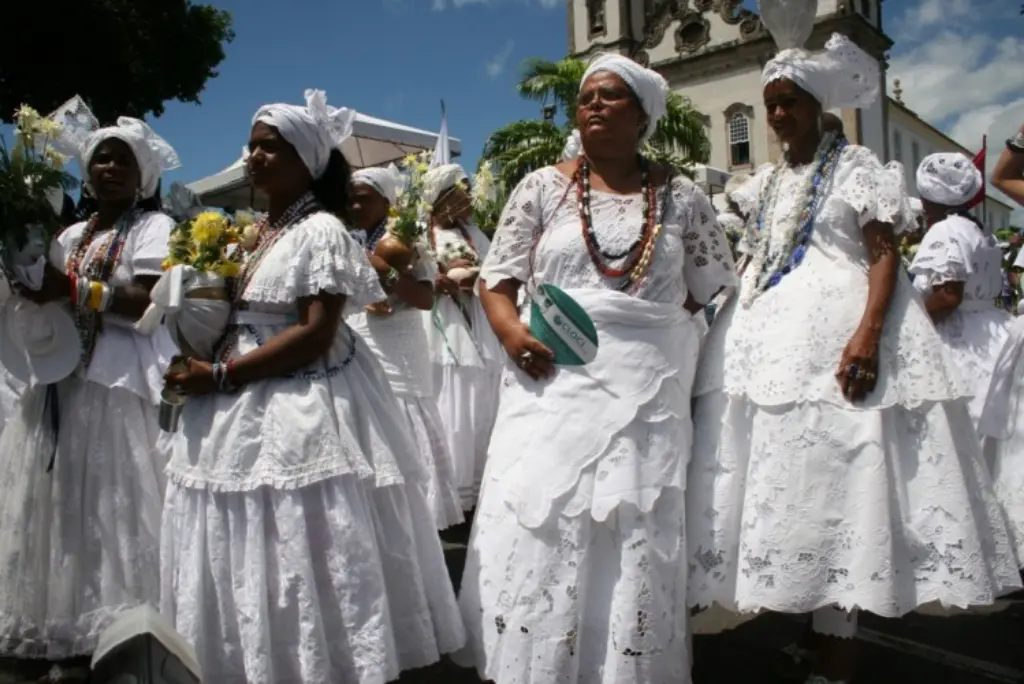
Functions of the Baiana Dress in Rituals
- Honoring Orixás: Clothing is a way of showing respect and honoring the deities, which is crucial for the efficacy of ceremonies.
- Symbolic Transformation: Wearing the dress helps the “Filha de Santo” to transcend everyday life and enter a spiritual realm.
- Community Identity: The Baiana dress strengthens the sense of belonging and cultural identity within the Candomblé community.
- Visual Spectacle: The colorful and elaborate attire creates a visually stunning aspect of the ceremonies, drawing attention to their religious significance.
- Spiritual Conduit: The dress acts as a conduit, facilitating the connection between the wearer and the divine energy of the Orixás.
The movements of the dancers, combined with the flowing fabrics of the Baiana dress, create a visual spectacle that is both spiritually powerful and aesthetically captivating. The dress is a vehicle that carries the essence of the Orixá, making its presence known through the human form.
The Baiana Dress: Preservation and Evolution
The Baiana dress is not static. While its traditional features have been carefully preserved, it has also evolved with time and the specific contexts in which it is worn. This is especially true given influences from diverse ethnic backgrounds within Candomblé’s diverse community.
Factors Influencing the Evolution
- Availability of Materials: The specific fabrics, beads, and embellishments used in the dress can be influenced by material availability and trade routes.
- Regional Variations: Candomblé has regional variations across Brazil, which can be reflected in specific designs and embellishments.
- Personal Expression: While following traditional guidelines, practitioners sometimes introduce individual touches based on personal taste and family traditions.
- Contemporary Adaptations: In recent years, there’s been a growing awareness and appreciation for the Baiana dress as a cultural icon, leading to adaptations in mainstream fashion and art.
Despite these evolutions, the core essence and symbolism of the Baiana dress remain central to Candomblé practices. It is a living tradition that continues to adapt and grow, reflecting the dynamic nature of the religion itself.
The Baiana Dress Beyond Candomblé
The impact of the Baiana dress extends beyond Candomblé ceremonies. It has become an important symbol of Afro-Brazilian culture and identity. It’s a powerful representation of resistance, cultural pride, and artistic heritage.
The Dress as a Cultural Icon
- Art and Fashion: The Baiana dress inspires artists, fashion designers, and cultural practitioners in Brazil and beyond.
- Social Movements: It has been used in political demonstrations and social movements to assert Afro-Brazilian identity and call for equality.
- National Identity: The image of the Baiana woman in her traditional dress has become an iconic image of Brazilian culture.
- Tourist Attraction: In Bahia and other regions, the dress is often part of tourist experiences, highlighting the rich culture of the region.
- Educational Tool: The Baiana dress is often used as a valuable teaching tool, helping to educate people about the history and culture of Candomblé.
The Baiana dress stands as a living testament to the strength and resilience of Afro-Brazilian culture. It’s a reminder that traditions carry power and beauty while acting as crucial components of a culture’s identity. The dress is a beautiful expression of artistry and spirituality that continues to inspire and captivate. It embodies a rich history and the traditions of Candomblé, ensuring their legacy will continue for generations to come.
The Baiana dress, at the heart of Candomblé, is far more than just a garment; it’s a profound symbol of spirituality, culture, and resilience. Its intricate designs, vibrant colors, and layers of meaning reflect the rich tapestry of Afro-Brazilian heritage.
The dress is an essential part of religious expression, helping to connect the wearer with the divine and strengthening the ties within the community. It’s also a powerful cultural icon that has transcended religious boundaries, becoming a symbol of pride and resistance.
By understanding the significance of the Baiana dress, we can gain a deeper appreciation for the beauty and complexity of Candomblé and its profound contributions to Brazilian culture.“`

